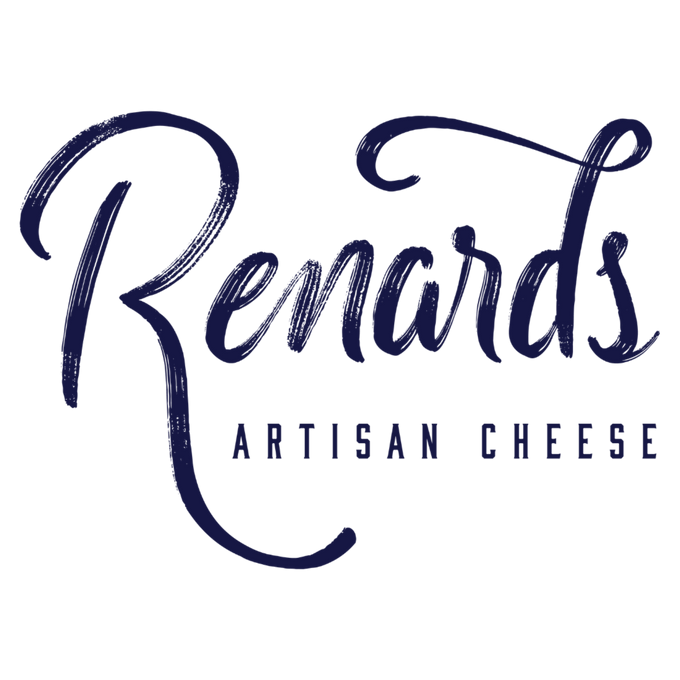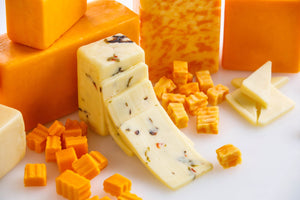Some say that cheese ages like a fine wine, and we couldn’t agree more.
You might be asking yourself, Why does cheese need to age? Simply put, without aging, some of our favorite cheeses wouldn’t exist! Swiss cheese would be without its iconic holes, Parmesan wouldn’t have its flavorful crystals or crumbly consistency, and Blue wouldn’t be, well, blue!
As cheese ages over time, it essentially becomes a different cheese. For instance, a fresh, young Cheddar and a 10-year Aged Cheddar will have different textures and flavor profiles, appealing to different parts of your palate. While they’re both Cheddars, you’d probably associate them as being “distant cousins” rather than siblings—that’s how different they are!
In Wisconsin, Master Cheesemakers have perfected the art and science of maturing our favorite cheeses, like Cheddar, Parmesan, and Asiago. Our own Chris Renard earned a Master Cheesemaker Certification in Cheddar, one of the most widely popular aged cheeses, which has enabled us to produce over 40 varieties of Cheddar for cheese lovers to enjoy!
Because Wisconsin is home to the most award-winning and high-quality cheeses around, you know the wait for an aged cheese is worth it. But are aged cheeses really better than young and soft cheeses? Well, that depends on your palate!
Regardless, whether you prefer your cheese sharp and tangy or more mellow and subdued, the aging process of cheese is a fascinating look at the combined art and science of cheesemaking.
What is cheese aging?
Aging cheese, also known as “ripening” or “affinage,” is the process of maturing cheese to develop its flavor and texture. While no longer squeaky and soft, the curds eventually become firm and bold cheeses with loads of personality and flavor.
The aging process develops unique and interesting flavors within the cheese that cheesemakers simply wouldn’t be able to obtain otherwise. They control conditions such as temperature and humidity over weeks, months, or even years to allow enzymes and microbes to transform and evolve the cheese. The maturation is determined based on the different bacterial or mold cultures first introduced to the cheese in the beginning of the cheesemaking process, as well as by altering the storage environment of the cheese to either speed up or slow down the aging.
The microbes that age the cheese are called “cultures.” As they mature, they’re growing and eating more and more of the lactose, turning it into lactic acid. After about eight months, all lactose has been converted into lactic acid. Through the lactic acid, flavors in the cheese intensify, textures change, and unique characteristics, such as crystals, form.
Can aged cheese go bad? Well, yes, but it has a much longer shelf life than young cheese because of its lower moisture content. When it’s unopened and kept cool, like in a refrigerator, aged cheese can last for several months! Even when opened, they can last for several weeks, and there are a multitude of ways you can prolong the life of your favorite aged cheese.
What happens during aging?
As cheese ages, several processes are taking place at once over a long period of time. For one, cheese loses its moisture, leading to a firmer texture that becomes dry and crumbly. Proteins and fat break down from the enzymes and bacteria—but not the sickly kind. These food-friendly bacteria transform the lactose into lactic acid, as mentioned before, and build other amino acids as well. Because all of the lactose eventually converts into lactic acid, most aged cheeses can be safely enjoyed by those with lactose intolerance!
The breakdown of proteins and fat develops a wide variety of flavors, from sharp and tangy in Aged Cheddar to nutty and savory in Parmesan. The texture of the cheese itself can also change, becoming harder, dryer, and crumblier. On some aged cheeses, an amino acid called tyrosine will create crystals on the cheese’s surface, which further adds to the texture and flavor.
Aging, as the name implies, doesn’t happen all at once when the cheese is wrapped and stored away. It’s a prolonged process, where different microbes are competing against each other for the nutrients within the cheese, and they each process those nutrients differently in different aging conditions. Cheesemakers will assess the life cycles of the microbes on the cheeses, and they work to either encourage or suppress the maturation of the cheese, depending on the cheese’s desired flavor profile.
Cheese aging conditions
So, can anyone age cheese? Well, technically, yes! You can age cheese in many different environments—even vacuum-sealed in a plastic bag in the cheese drawer of your refrigerator! However, certain cheeses need certain conditions to develop the flavor profiles that we know and love.
As mentioned previously, temperature and humidity are large components of the aging process. The ideal aging temperatures vary, but many cheeses are matured between 50 and 55 degrees Fahrenheit. Humidity levels also vary, as some cheeses require higher humidity than others.
Despite their variation, these levels for both temperature and humidity must be very precise for the aging to proceed successfully. Too much or too little humidity can ruin the rind or interior texture of the cheese. It can take years to perfectly master aging just one type of cheese!
When it comes to aging cheese, you don’t just set it and forget it. Cheesemakers must turn the cheese regularly during the maturing process to help ensure that the cheese ripens evenly and doesn’t dry unevenly.
There are a variety of different aging techniques that cheesemakers employ all over the globe. One of them is surface ripening, where cheese is aged from its surface all the way through to its past. Cheesemakers will rub the cheese with washes, brine, and other microorganisms, which will give the surface of the cheese a unique and tasty rind (yes, those are edible!).
Another common technique is interior ripening, which is essentially the opposite of surface ripening. Here, the cheese is aged inside out! To do this, cheesemakers will wrap the cheese in wax, cloth, or muslin to keep the surface from aging. With the exterior wrapped, the aging process occurs within the cheese’s interior, producing a rindless, smooth cheese that gets softer the closer you get to the center.
Fun Fact: Most cheeses were traditionally aged in caves, a trend that’s coming back as cheesemakers continue to search for the best and most flavorful cheese they can create!
What are some commonly aged cheeses?
The best cheeses for long maturation are hard cheeses that have a very low moisture content. Soft cheeses can be aged, but if the aging is prolonged further than it should be, the cheese can become too soft. Some cheeses, like Chevre or Ricotta, have higher water content than others, and they’re best eaten fresh. Aging them, with their high water content, would lead to “off” flavors in the cheese, like a strong taste of ammonia, that wouldn’t be particularly pleasant on the palate.
Some of the best cheeses for aging include:
· Cheddar: Our 15 Year Aged Cheddar is the oldest cheese we offer! This is an intense cheddar with a strong and flavorful bite, complete with the tyrosine crystals that add a special crunch. Extremely nutty with a note of caramel, this is a cheese best enjoyed paired with your favorite aged wine or straight off the block!
· Parmesan: Parmesan is one of the most commonly aged cheeses, as it requires a minimum of one year to reach its widely loved buttery and nutty flavor. This maturation is also what leads it to have its iconic crumbly texture, which is easy to grate or sprinkle over a bowl of pasta.
· Asiago: Made with whole milk, Asiago is a firm cheese with sharp and tangy notes, very similar to Parmesan. The aging process of this cheese lends itself to a more earthy flavor profile and tangy aroma, as opposed to the strong nuttiness commonly found in aged cheddars.
· Blue: Without cheese aging, we wouldn’t have Blue cheese! Our Blue cheese is mildly salty, creamy, and earthy, perfect for serving with salads or atop of a burger. Of course, Blue cheese isn’t for everyone—the mold lends itself to a sharp pungency that’s alluring to some and abhorrent to others! It all depends on your own palate’s preferences.
· Brick: Another aged cheese that’s deliciously bold, but not for the faint of heart, is Brick cheese. It’s similar to Limburger in taste and smell, with a very strong, pungent odor and flavor. If you’re looking for something unique and adventurous to add to your next gourmet cheese board, you can’t go wrong with Brick! (Though maybe ask the rest of your guests if they mind the smell!)
· Gruyere: A Swiss-style aged cheese made from cow’s milk is Gruyere, a delectable treat with a nutty and slightly sweet flavor. Enjoy the distinct tasting notes of caramel, brown butter, and roasted nuts that’s brought about through the maturation process.
· Gouda: Another popular aged cheese is Gouda, a Dutch-style cheese with a smooth and creamy texture. Its uses are very versatile, ranging from being melted in a fondue to being added to a sandwich to simply being enjoyed as a snack atop a cracker!
Now that you’re familiar with the process of aging cheese and all of the science that goes into it, it’s time to put your knowledge to the test! Check out our wide variety of aged cheeses online or in our store to indulge in a classic, like Parmesan or Asiago, or discover a new favorite, like our Terrific Trio or aged Cheddars.




